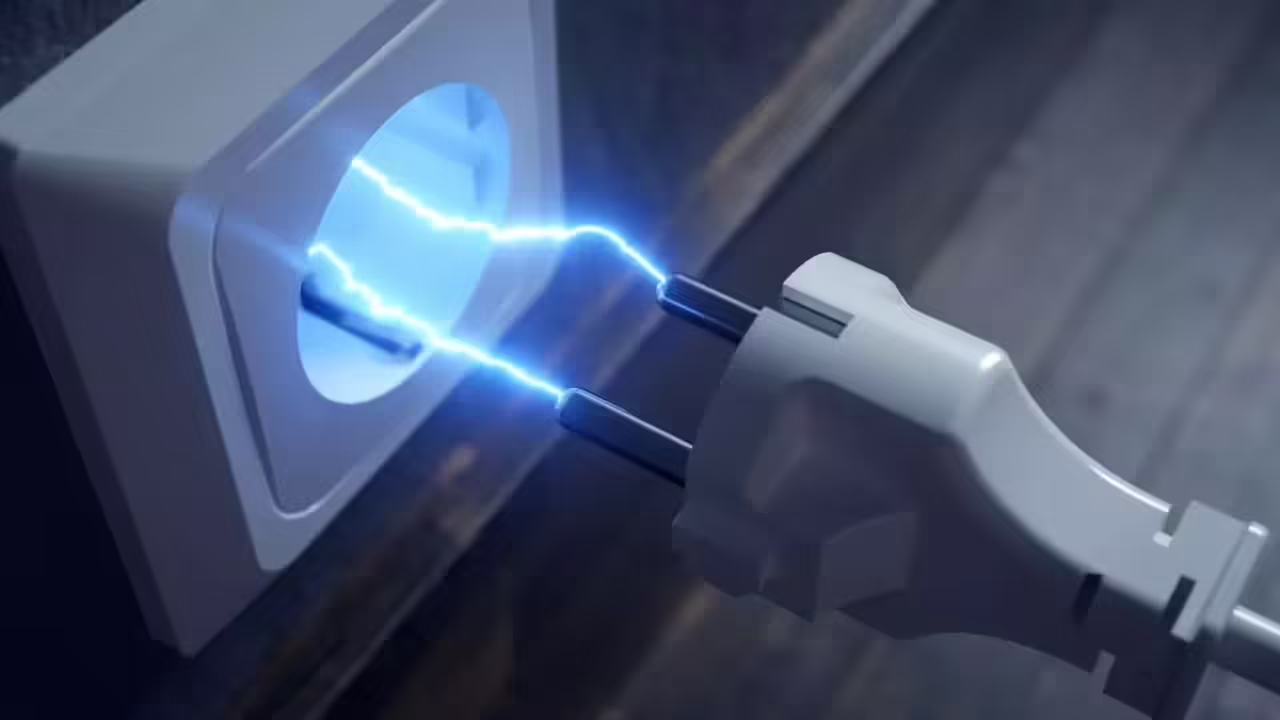
Electricity is a physical phenomenon that manifests itself as a current of electrons through a conductive material. Electricity can be generated in various ways, such as by the movement of a magnet inside a coil of wire, known as electromagnetic induction. Electricity can also be produced by the transformation of other forms of energy, such as chemical, thermal or solar.
Electricity has many applications in everyday life, from lighting and heating to communication and transportation. Electricity can be measured in different units, such as voltage, current, resistance or power. Electricity can also be classified into different types, such as static, dynamic, alternating or direct current.
Electricity is a very broad and complex field of study, encompassing various disciplines such as physics, chemistry, engineering and electronics. Electricity is a very important source of energy for human development, but it also involves certain risks and challenges, such as electrical accidents, pollution or the depletion of natural resources.How is electricity produced?
How is electricity transmitted?
One way of transmitting electricity is by means of conducting wires, such as those used in power grids. Conductor cables allow electric current to flow from the source of generation, such as a hydroelectric power plant or solar plant, to the points of consumption, such as homes or industries. Conductor cables are usually made of metals, such as copper or aluminum, which have a low resistance to the passage of electricity.
Another way of transmitting electricity is by electromagnetic waves, such as those used in wireless communications. Electromagnetic waves are oscillations of electric and magnetic fields that propagate through space without the need for a material medium. Electromagnetic waves can carry information encoded in their frequency, amplitude or phase, such as radio, television or Internet signals. Electromagnetic waves are generated by transmitting devices, such as antennas or satellites, and received by receiving devices, such as radios or telephones.
The transmission of electricity is a fundamental process for the development of society, as it allows electrical energy to be used for multiple purposes, such as lighting, transportation, communication or production. Electricity transmission also involves technical and environmental challenges, such as ensuring the safety, efficiency and sustainability of the electricity system.
How is electricity stored?
Electricity storage is a process of storing electrical energy in a device or system that can release it later. Electricity storage has several advantages, such as:
Increasing the security and reliability of the electricity supply, by being able to have energy reserves available in case of emergencies or grid failures.
Improving the efficiency and performance of renewable energy sources, such as solar or wind, which are intermittent and dependent on weather conditions.
Reduce costs and greenhouse gas emissions by avoiding energy waste and the use of fossil fuels to generate electricity.
There are different types of electricity storage, depending on the physical or chemical principle used. Some of the most common are:
Batteries: these are devices that store electricity through reversible chemical reactions between two electrodes and an electrolyte. Batteries can be recharged by applying an external electric current that reverses the chemical process. Batteries are used to store small amounts of energy, such as in cell phones, laptops or electric cars.
Capacitors: These are devices that store electricity by separating electrical charges on two metal plates separated by an insulating material. Capacitors can be charged and discharged quickly, but have a low storage capacity. Capacitors are used to store energy in electronic circuits or to regulate voltage in the electrical grid.
Flywheels: These are devices that store electricity by converting electrical energy into kinetic energy, i.e., into motion. Flywheels consist of a disk or cylinder that rotates at high speed on an axis. To charge the flywheel, an electric current is applied to it, which makes it spin faster. To unload the flywheel, it is connected to an electric generator that harnesses its motion to produce electricity. Flywheels are used to store energy in industrial or space systems.
Hydrogen: A gas that can be obtained by electrolysis of water, i.e., by passing an electric current through water to separate the hydrogen from the oxygen. Hydrogen can be stored in tanks or reservoirs at high pressure or low temperature. To release electricity, the hydrogen can be burned with oxygen in a fuel cell or turbine. Hydrogen is used to store large amounts of energy, such as in power plants or environmentally friendly vehicles.
Hydraulic pumping: A system that stores electricity by lifting water from a lower level to a higher level using a pump driven by an electric motor. The water is stored in a reservoir or upper tank. To recover electricity, water is dropped from the upper level to the lower level, passing through a turbine connected to an electric generator. Hydraulic pumping is used to store large amounts of energy, as in hydroelectric power plants.
These are just a few examples of how electricity is stored, but there are other more innovative and experimental methods, such as compressed air, molten salts or graphene. Electricity storage is a very important field of research and development that can contribute to improving energy efficiency and reducing the environmental impact of electricity generation.
How is electricity generated?
Another question that seems simple, but hides a wide variety of processes. Electricity can be generated in many ways, for example:
By moving magnets near coils of wire, which induces an electric current in the circuit. This is the basic principle of power plants using fossil fuels, nuclear power or hydroelectric power.
By harnessing sunlight, which when it strikes certain semiconductor materials, such as silicon, causes electrons to be displaced and generates an electric potential difference. This is the basic principle of the photovoltaic cells used in solar panels.
Through the use of chemical reactions, which, by producing or consuming electrons at the ends of a conductor, create an electric current. This is the basic principle of cells and batteries.
By harnessing thermal energy, which by heating a conductive material, increases its electrical resistance and causes a voltage difference between its ends. This is the basic principle of the thermoelectric or Seebeck effect, which is used in some electric generators.
By harnessing mechanical energy, which, when deforming a piezoelectric material such as quartz, produces an electrical charge on its surface. This is the basic principle of electric lighters or microphones.
What effects does electricity have on living things? Electricity is vital for life, as it is involved in many biological processes, such as the transmission of nerve signals, muscle contraction or photosynthesis. But it can also be dangerous if applied in excess or in the wrong places. Electricity can cause burns, paralysis, cardiac fibrillation or even death if it passes through the human body with sufficient intensity or duration. On the other hand, electricity can also have beneficial effects if used for therapeutic purposes, such as:
To stimulate bone growth or wound healing through weak electrical currents.
To relieve pain or improve mood through transcranial electrical stimulation (tDCS), which involves applying a low-intensity direct current to the scalp.
To treat neurological or psychiatric conditions using deep brain stimulation (DBS), which involves implanting electrodes in specific areas of the brain and sending controlled electrical impulses to them.
What are the dangers of electricity?
Electricity is a form of energy that is used to light, heat, communicate and move the world. However, it can also be very dangerous if not used with caution and respect. Electricity can cause burns, electrocution, fires, explosions and damage to electrical equipment. Next, we will explain some of the most common hazards of electricity and how to avoid them.
Burns: Electricity can produce intense heat as it passes through a conductor, such as a wire or metal. This heat can burn the skin, internal tissues and organs of a person who comes in contact with the conductor. Electrical burns can be superficial or deep, and may require urgent medical attention. To prevent electrical burns, avoid touching exposed or damaged conductors, wear appropriate personal protective equipment, and disconnect the power source before performing any electrical work.
Electrocution: Electrocution occurs when an electric current passes through the human body, disrupting the normal functioning of the heart, brain and nervous system. Electrocution can cause cardiac arrest, brain damage, seizures and death. To avoid electrocution, keep a safe distance from overhead or subway power lines, do not use electrical appliances in damp places or near water, and check that plugs and cords are in good condition.
Fires: Electricity can generate sparks or electrical arcs that can ignite flammable materials such as paper, cloth, wood, or gas. Electrical fires can spread quickly and cause property damage and personal injury. To prevent electrical fires, avoid overloading circuits or multiple outlets, do not leave electrical appliances on unattended, and keep fire extinguishers on hand.
Explosions: Electricity can cause explosions when it comes in contact with chemicals or gases that react violently with it. Electrical explosions can release shock waves, heat and debris that can injure or kill nearby people. To avoid electrical explosions, store and handle chemicals and gases carefully, follow established safety rules, and do not use electrical appliances in hazardous areas.
Damage to electrical equipment: Electricity can damage electrical equipment by causing short circuits, surges or electrostatic discharges. These phenomena can affect the normal operation of electronic devices such as computers, telephones or household appliances. Damage to electrical equipment can cause loss of information, malfunctions or breakdowns. To protect electrical equipment, voltage regulators, surge protectors and grounding devices should be used.
As we have seen, electricity can be very useful but also very dangerous. Therefore, it is important to be aware of its risks and take the necessary measures to avoid them. In this way, we can enjoy its benefits without endangering our own lives or those of others.
What is electromagnetism and how does it work?
Electromagnetism is one of the four fundamental forces of nature, along with gravity, the strong nuclear force and the weak nuclear force. Electromagnetism deals with the interactions between electrically charged particles, such as electrons and protons, and the electric and magnetic fields they generate and are in turn affected by them.
Electromagnetism is based on two key concepts: Coulomb’s law and Ampère’s law. Coulomb’s law states that electric charges of the same sign repel each other and those of opposite sign attract each other, with a force proportional to the product of the charges and inversely proportional to the square of the distance between them. Ampère’s law states that an electric current, i.e., a flow of moving charges, generates a magnetic field around it, whose direction depends on the direction of the current and whose intensity depends on the amount of charge circulating per unit time.
These two laws can be unified in a single equation, known as Lorentz’s law, which describes the force acting on an electric charge moving in the presence of an electric and a magnetic field. Lorentz’s law is the basis of the classical theory of electromagnetism, formulated by James Clerk Maxwell in the 19th century, which explains phenomena such as light, electromagnetic waves, magnetism, static electricity and the photoelectric effect.
Electromagnetism has numerous applications in science, technology and everyday life. Some examples are:
Magnets, which can be used to generate electricity by relative motion between a conductor and a magnetic field (electromagnetic induction), or to store information in devices such as hard disks or magnetic cards.
Electric motors, which convert electrical energy into mechanical energy through the use of coils that rotate when interacting with magnetic fields.
Loudspeakers, which convert electrical energy into sound by using membranes that vibrate when subjected to varying magnetic fields.
X-rays, which are high-frequency, high-energy electromagnetic waves that can be used to obtain images of the inside of the human body or other objects.
Microwaves, which are low-frequency, low-energy electromagnetic waves that can be used to heat food or to communicate via satellites or cell phones.
Lasers, which are beams of coherent, monochromatic light that can be used to cut materials, measure distances or transmit information.







